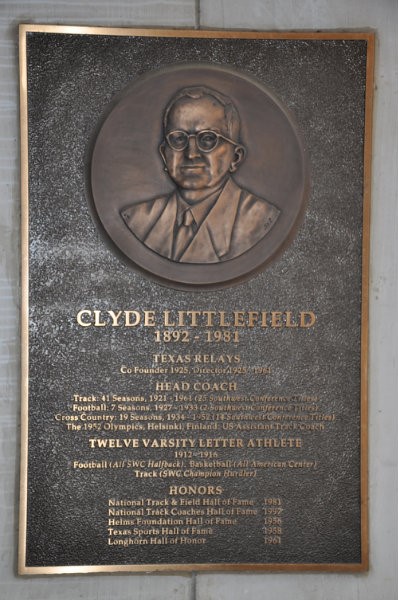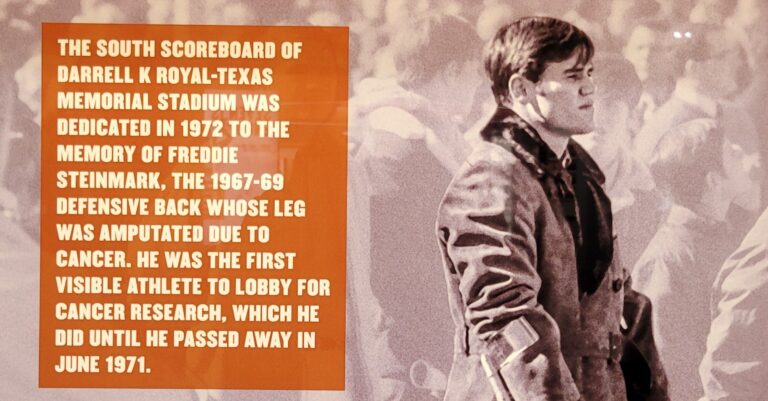Littlefield the Greatest All Round Longhorn Athlete of All Times
Littlefield personified the all-around athlete
By Gaylon Krizak
A couple of years ago, the Longhorn Network aired a program designed to identify the greatest athlete in the history of the University of Texas. Special attention was paid to football players; not surprising at UT.
Also not surprising: The greatest all-around athlete in Longhorn’s history wasn’t even on the ballot.
With all due respect to Earl Campbell, Vince Young and Ricky Williams, they totaled fewer varsity letters than Clyde Littlefield accumulated on his own. Even the man acknowledged for greatness as a multisport athlete, Bobby Layne, couldn’t hold a candle to Littlefield when it came to breadth of accomplishments.
Between the fall of 1912 and the spring of 1916, Littlefield earned 12 varsity letters: four each in football, basketball and track. He even pitched for the baseball team in the 1912 and 1915 seasons, winning a couple of games but not making enough appearances to become a four-sport letterman, something the school never has had.
And while lettering in three sports wasn’t all that uncommon at the time – Pete Edmond, for example, accomplished the same football-basketball-track trifecta in 1913-14 – it was Littlefield’s prowess in each endeavor that set him apart.
The Aug. 7, 1915, Austin Statesman and Tribune, sizing up football prospects for the coming season, described Littlefield:
“He weighs, when in condition, 180 pounds. He is six feet one inch and a half in heighth [sic], and is as agile as a catamount. He runs 100 yards in 10½ seconds, is sure footed like a llama, and he knows the game. … He keeps his head as well as his feet; he has personality, confidence and generalship …
“Athletic Director (L. Theo) Bellmont does not hesitate to class Littlefield among the five best all-round college athletes he has ever known.”
In football, for example, Littlefield was one of the sport’s first dangerous passers (the forward pass had been legalized in 1906 but took a few years to become truly integrated as a weapon by most teams). Statistics from the era are sketchy and rudimentary at best, but Littlefield – playing primarily fullback and halfback in the alignments of the day – in 28 games spanning four seasons accounted for at least 31 touchdowns rushing and passing, including a seven-TD (three rushing, four passing) performance in 1915 against Daniel Baker College. He was named to the All-Southwest Conference team in 1915, the league’s inaugural season after being named to several informal all-state or all-region teams in previous seasons.
He may have been even better at basketball, where, under Bellmont’s coaching, he was the team’s center for four years and the team captain as a junior and a senior. Littlefield, the Southwest Conference’s first scoring champion, also was on the first All-SWC basketball team and later was retroactively named to the Helms Foundation All-America team for 1915.
Clyde Littlefield
Still, as noted in Lou Maysel’s May 22, 1981, obituary of Littlefield, track “was Littlefield’s first love.”
“He lost only one hurdles race, the 220-yard low hurdles at the 1915 inaugural SWC meet to arch rival John Jacobs of Oklahoma, over four years. His top feat was equaling the world’s record in the 120 highs at the state collegiate (TIAA) meet in 1914. The 15.2 time would be laughable now, but tracks were primitive then as was the common hurdling style, which involved tucking the lead leg as well as the trailing leg.”
Littlefield led four track teams at UT that completed their seasons undefeated, which also could be said for the first three Longhorns basketball teams on which he played as well as the 1914 football team. In his final official performance for the University, Littlefield swept the hurdles events at the SWC track meet on May 13, 1916, in College Station, winning the 120 highs in 15.4 seconds and the 220 lows in 25.4.
Of course, that was far from the end of Littlefield’s time on the Forty Acres. After coaching track and football at Greenville High School for three years – interrupted by one year as an instructor at an officers training corps during World War I – he returned to Austin in 1920 “as head track coach and freshman football and basketball coach,” according to Littlefield’s biography for the UT Kinesiology and Health Education Hall of Honor:
“He also worked as an instructor in the Men’s Physical Training Program, where he taught academic and physical training classes. Littlefield’s joint appointment as coach and faculty member was common in this era; nearly all of UT’s athletic coaches also held academic appointments before the 1960s.”
In 1927, Littlefield was promoted to head football coach, in addition to his track duties. In seven seasons, his teams won two SWC championships (1928 and 1930) and compiled a 44-18-6 record, the final tie coming in his last game at Texas A&M, by which time Littlefield already had submitted his resignation. The 1933 A&M game concluded the first losing season (4-5-2) in program history.
Littlefield’s most enduring contribution to the football program may have been his decision before the 1928 season to outfit his teams in burnt orange jerseys (more on which can be found elsewhere on this website).
Texas Relays
His exit from the football sidelines came with a proviso: Littlefield was allowed to stay on as track coach. He did so until 1961, leading Texas to 25 SWC team titles while coaching 12 NCAA individual champions and three Olympians. In addition, Littlefield and Bellmont teamed up in 1925 to create the Texas Relays to answer similar successful meets at Drake, Penn, and Kansas. Since 1963, the wildly successful meet has been known as the Clyde Littlefield Texas Relays.
In his wake athletically, the University continued to produce outstanding multisport athletes, primarily Layne (Hall of Fame quarterback, unbeaten in SWC games as a pitcher) and Tom Hamilton (All-America first baseman on the Longhorns’ first national-champion baseball team, All-SWC in basketball on UT’s first Final Four team). But, as sports generally became more specialized over time, no one has come along to match or even approach Littlefield’s prowess.
REFLECTION POINT FOR CLYDE LITTLEFIELD
Information supplied by Conrad Derdeyn follows:
Clyde Littlefield was outstanding in all sports; he Earned 12 varsity letters in football, basketball, and baseball. He was on one undefeated football team, making all-conference twice; In track, he never ran on a beaten team and lost only one hurdle race but equaled the world high hurdles record in 1914. In basketball, Clyde played on three undefeated teams winning high point man for two years.
In 1920 he was hired as the Longhorn track coach, freshman football coach, freshman basketball coach, and instructor in physical training. From 1927 – 1933 he was the Head football coach, winning two SWC championships and posting a 43-18-6 record.
At Texas, he produced 25 SWC champions and 14 runner-ups.
Clyde Littlefield founded the Texas relays, and for 32 years, he was the relay director.
On April 4th, 1963, there was an Honor Day. Copies of the original letters are shown in a slide-show format.












